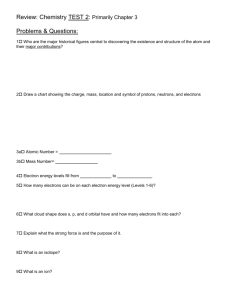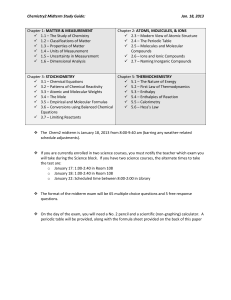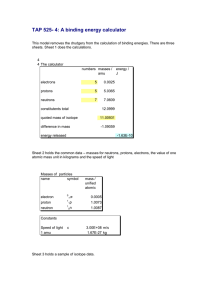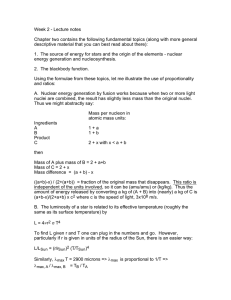Answer Key - profpaz.com
advertisement
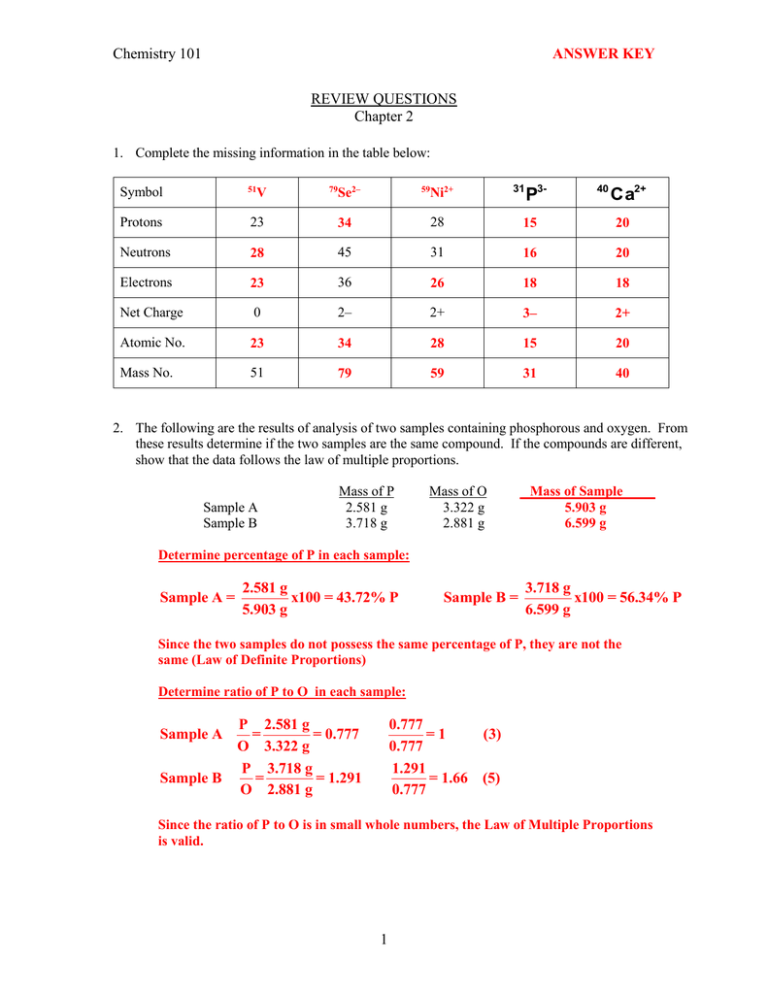
Chemistry 101 ANSWER KEY REVIEW QUESTIONS Chapter 2 1. Complete the missing information in the table below: Se2– 59 Ni2+ P3- 40 Ca2+ 51 Protons 23 34 28 15 20 Neutrons 28 45 31 16 20 Electrons 23 36 26 18 18 Net Charge 0 2– 2+ 3– 2+ Atomic No. 23 34 28 15 20 Mass No. 51 79 59 31 40 V 79 31 Symbol 2. The following are the results of analysis of two samples containing phosphorous and oxygen. From these results determine if the two samples are the same compound. If the compounds are different, show that the data follows the law of multiple proportions. Sample A Sample B Mass of P 2.581 g 3.718 g Mass of O 3.322 g 2.881 g Mass of Sample 5.903 g 6.599 g Determine percentage of P in each sample: Sample A = 2.581 g x100 = 43.72% P 5.903 g Sample B = 3.718 g x100 = 56.34% P 6.599 g Since the two samples do not possess the same percentage of P, they are not the same (Law of Definite Proportions) Determine ratio of P to O in each sample: Sample A Sample B P 2.581 g = = 0.777 O 3.322 g P 3.718 g = = 1.291 O 2.881 g 0.777 =1 (3) 0.777 1.291 = 1.66 (5) 0.777 Since the ratio of P to O is in small whole numbers, the Law of Multiple Proportions is valid. 1 3. Gallium has two naturally occurring isotopes with the following masses and natural abundances: Isotope Ga-69 Ga-71 Mass (amu) 68.9258 70.92470 Abundance (%) 60.108 39.892 Using the information above, sketch the mass spectrum of Gallium. The intensity of the more abundant isotope is set to 100 in the mass spectrum. The intensity of the other isotope can be calculated relative to the other as shown below: Ga-69 =100% Ga-71 = 39.892 x100 = 66.4% 60.108 4. On a dry day, your body can accumulate static charges from walking across a carpet or from brushing your hair. If your body develops a charge of –15 C, how many excess electrons has is acquired, and what is the mass (in grams) of these electrons? (Use the information about mass of charge of electrons included in page 2 of Chapter 2 lecture notes) 1x10-6 C 1 electron -15 μC x x = 9.4x1013electrons -19 1 μC -1.60218x10 C 5.5x10-4 amu 1g 9.4x10 electrons x x = 8.6x10-14 g 23 1 electron 6.02x10 amu 13 5. Three different samples of a solid containing mercury and oxygen were analyzed and the following data was obtained: Sample A Sample B Sample C Mass of Sample 1.0410 g 1.5434 g 1.2183 g Mass of Mercury 0.9641 g 1.4293 g 1.1283 g Mass of Oxygen 0.0769 g 0.1141 g 0.0900 g Are these data consistent with the hypothesis that the material is a compound? Calculate the percentage of mercury in each sample: 0.9641 g Sample A % mercury = x 100 = 92.61% 1.0410 g 1.4293 g Sample B % mercury = x 100 = 92.61% 1.5434 g 1.1283 g Sample C % mercury = x 100 = 92.61% 1.2183 g Since all sample have the same percentage of one element (fixed composition), all samples are therefore the same compound. 2 6. An particle (4He2+) has a mass of 4.00151 amu. Find the value of its charge-to-mass ratio in Coulombs/kg (C/Kg). 2 protons x 1.60218x10-19C 1 6.02x1023 amu 103 g x x x = 4.82x107C/kg 1 proton 4.00151 amu 1 g 1 kg 7. Write isotopic symbols in the form of X-A (e.g. C-13) for each isotope listed below: a) The copper isotope with 34 neutrons Cu-63 b) The uranium isotope with 146 neutrons 8. U-238 Use the mass spectrum of lead, shown below, to determine the atomic mass of lead. (Estimate the values from the graph to 3 significant figures) Calculate relative abundance of each isotope from its intensity in the mass spectrum 2.67 x100 = 1.40% 190.87 46.0 Pb-206 = x100 = 24.1% 190.87 42.2 Pb-207 = x100 = 22.1% 190.87 100 Pb-209 = x100 = 52.4% 190.87 Pb-204 = Atomic mass = (204x0.0140)+(206x0.241)+(207x0.221)+(209x0.524)= 207.8 amu 3 9. The atomic mass of fluorine is 18.998 amu and its mass spectrum shows a large peak at this mass. The atomic mass of chlorine is 35.45 amu, but the mass spectrum of chlorine does not have a peak at this mass. Explain the difference. The fluorine isotope with mass of 19 amu is abundant by a very large amount, causing the average mass of fluorine to be close to 19 and producing a large peak in its mass spectrum. Chlorine however, has two isotopes which are not in great excess of one another. Therefore, the average mass of chlorine is not equal to one of its isoptopes and therefore no peak appears at this value in its mass spectrum. 10. Calculate the molar mass of each substance shown below: a) (NH4)3PO4 149.12 g/mol b) CuSO4 5 H2O 249.71 g/mol 11. Calculate the mass (in grams) of each of the following: a) 2.3x10–3 mol Sb 2.3x10-3 mol x 121.76 g = 0.28 g 1 mol b) 1.8x1022 lead atoms 1.8x1022 atoms x 1 mol 207.5 g x = 6.2 g 23 6.02x10 atoms 1 mol 12. Brass is a copper and zinc alloy containing 37.0% zinc by mass and has a density of 8.48 g/cm3. A brass fitting has a total volume of 112.5 cm3. How many copper atoms does this fitting contain? 8.48 g 63.0 g Cu 1 mol 6.02x1023 atoms 112.5 cm brass x x x x = 5.69x1024 atoms Cu 3 100 g brass 63.55 g 1 mol 1 cm 3 4
